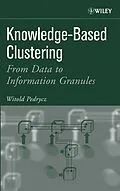* A comprehensive coverage of emerging and current technology
dealing with heterogeneous sources of information, including data,
design hints, reinforcement signals from external datasets, and
related topics
* Covers all necessary prerequisites, and if necessary,additional
explanations of more advanced topics, to make abstract concepts
more tangible
* Includes illustrative material andwell-known experimentsto
offer hands-on experience
Autorentext
WITOLD PEDRYCZ, PHD, is a Professor and Canada Research Chair at the University of Alberta, Canada. He is also with the Systems Research Institute of The Polish Academy of Sciences, Warsaw, Poland. Dr. Pedrycz is a Fellow of the IEEE, has authored nine research monographs, edited six volumes, and has written numerous papers in computational intelligence, granular computing, pattern recognition, quantitative software engineering, and data mining.
Klappentext
Discover the latest powerful tools in knowledge management
Knowledge-Based Clustering demonstrates how to design navigational platforms that enable information seekers to make sense of and better exploit highly diverse and heterogeneous sets of data. Moving beyond fuzzy clustering, the author shows how the promising new paradigm of knowledge-based clustering can reveal more meaningful data structure and enable society to better cope with the ever-growing flood of data and information. With this book, readers come to understand the fundamentals of knowledge-based clustering and its associated algorithms, and then learn to apply their knowledge to system modeling and design.
The book begins with an introduction to the field and a discussion of fuzzy clustering and granular computing. Then, the author delves into logic-based neurons and ensuing neural networks. The core part of the book consists of nine chapters in which highly diversified methodologies of knowledge-based clustering are presented and analyzed. The third section of the book is devoted to models, beginning with a discussion of the hyperbox architectures and then moving on to granular mappings and linguistic models.
All the tools and guidance needed to understand and master this exciting new field are provided:
- Numerous practical examples illustrating key concepts
- Reproducible experiments that offer readers the opportunity for hands-on experience
- Comprehensive coverage of prerequisites that set the foundation for complex algorithms and modeling
- Conclusion section at the end of each chapter that emphasizes the key points needed to move forward in the text
- References plus an extensive bibliography leading to further avenues of exploration on specialized topics
This is must reading for researchers, professionals, and students interested in clustering, fuzzy clustering, unsupervised learning, neural networks, fuzzy sets, pattern recognition, and system modeling. With the author's emphasis on mastering the prerequisites, coupled with carefully constructed practical examples and experiments, readers will be well on their way to becoming knowledge-based clustering experts themselves.
Zusammenfassung
- A comprehensive coverage of emerging and current technology dealing with heterogeneous sources of information, including data, design hints, reinforcement signals from external datasets, and related topics
- Covers all necessary prerequisites, and if necessary,additional explanations of more advanced topics, to make abstract concepts more tangible
- Includes illustrative material andwell-known experimentsto offer hands-on experience
Inhalt
Foreword.
Preface.
1. Clustering and Fuzzy Clustering.
1. Introduction.
2. Basic Notions and Notation.
2.1 Types of Data.
2.2 Distance and Similarity.
3. Main Categories of Clustering Algorithms.
3.1 Hierarchical Clustering.
3.2 Objective Function Based Clustering.
4. Clustering and Classification.
5. Fuzzy Clustering.
6. Cluster Validity.
7. Extensions of Objective Function-Based Fuzzy Clustering.
7.1 Augmented Geometry of Fuzzy Clusters: Fuzzy C-Varieties.
7.2 Possibilistic Clustering.
7.3 Noise Clustering.
8. Self Organizing Maps and Fuzzy Objective Function Based Clustering.
9. Conclusions.
References.
2. Computing with Granular Information: Fuzzy Sets and Fuzzy Relations.
1. A Paradigm of Granular Computing: Information Granules and their Processing.
2. Fuzzy Sets as Human-Centric Information Granules.
3. Operations on Fuzzy Sets.
4. Fuzzy Relations.
5. Comparison of Two Fuzzy Sets.
6. Generalizations of Fuzzy Sets.
7. Shadowed Sets.
8. Rough Sets.
9. Granular Computing and Distributed Processing.
10. Conclusions.
References.
3. Logic-Oriented Neurocomputing.
1. Introduction.
2. Main Categories of Fuzzy Neurons.
2.1 Aggregative Neurons.
2.2 Referential (reference) Neurons.
3. Architectures of Logic Networks.
4. Interpretation Aspects of the Networks.
5. The Granular Interfaces of Logic Processing.
6. Conclusions.
References.
4. Conditional Fuzzy Clustering.
1. Introduction.
2. Problem Statement: Context Fuzzy Sets and Objective Function.
3. The Optimization Problem.
4. Computational Considerations of Conditional Clustering.
5. Generalizations of the Algorithm Through the Aggregation Operator.
6. Fuzzy Clustering with Spatial Constraints.
7. Conclusions.
References.
5. Clustering with Partial Supervision.
1. Introduction.
2. Problem Formulation.
3. The Design of the Clusters.
4. Experimental Examples.
5. Cluster-Based Tracking Problem.
6. Conclusions.
References.
6. Principles of Knowledge-Based Guidance in Fuzzy Clustering.
1. Introduction.
2. Examples of Knowledge-Oriented Hints and their General Taxonomy.
3. The Optimization Environment of Knowledge-Enhanced Clustering.
4. Quantification of Knowledge-Based Guidance Hints and Their Optimization.
5. The Organization of the Interaction Process.
6. Proximity Based Clustering (P-FCM).
7. Web Exploration and P-FCM.
8. Linguistic Augmentation of Knowledge-Based Hints.
9. Concluding Comments.
References.
7. Collaborative Clustering.
1. Introduction and Rationale.
2. Horizontal and Vertical Clustering.
3. Horizontal Collaborative Clustering.
3.1 Optimization Details.
3.2 The Flow of Computing of Collaborative Clustering.
3.3 Quantification of the Collaborative Phenomenon of the Clustering.
4. Experimental Studies.
5. Further Enhancements of Horizontal Clustering.
6. The Algorithm of Vertical Clustering.
7. A Grid Model of Horizontal and Vertical Clustering.
8. Consensus Clustering.
9. Conclusions.
References.
8. Directional Clustering.
1. Introduction.
2. Problem Formulation.
2.1 The Objective Function.
2.2 The Logic Transformation Between Information Granules.
3. The Algorithm.
4. The Overall Development Framework of Directional Clust...
